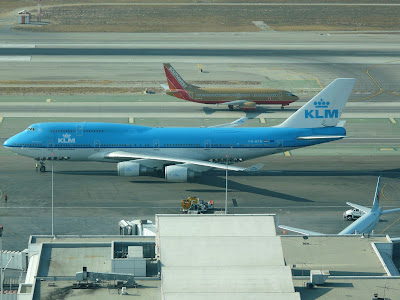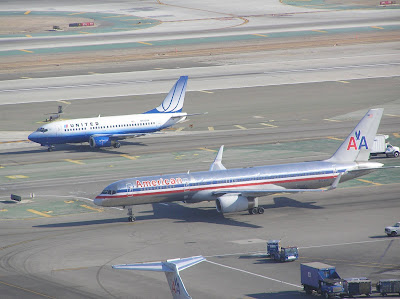Last time, I showed you who brings (or used to bring) B737s into LAX. I mentioned various different models or versions of the B737, denoted by their 'dash' numbers. This time around, we'll start looking at those different models, with some identifying notes. I'm going to skip the -200s because 1) We don't see them at LAX hardly ever anymore - I can't even remember the last one I saw; and 2) I haven't any additional -200 pictures to show you anyway. In this segment, I'm going to look at the models that came after the original B737s (the -100 and -200). This follow-on series of models (the -300/-400/-500) is now referred to as the Classics; these have been replaced by the current production Next Generation models, which we'll look at next time.
B737-300, aka B733


When we're discussing B733s at LAX, we're for the most part talking about Southwest Airlines. Southwest is the predominant operator of -300s at LAX these days, although Continental does show up with one from time to time
(2011 update: not any more). Formerly, Frontier and United also had them here (both now have Airbuses instead), as did America West and US Airways. Developed in the early 1980's, the -300 was the first of the second-generation, now referred to as Classic, B737s; the last one was built in 1999. The B733 is nearly ten feet (three meters) longer than the B732 and has a slightly greater wingspan. The most obvious difference, however, is the engines, which are much larger (and more efficient) turbofans. Unlike the original B737s, whose engines were under the wings, the new -300's engines are cantilevered out ahead of the wing. This was done to accommodate the new engine's much larger diameter. Passenger capacity of the B733 is 149 in maximum density configuration, about 20 more than the B732. It used to be that you could tell a Classic B737 from a Next Generation model by the presence or absence of winglets, but no longer. Southwest and Continental have both retrofitted some of their Classic models with winglets; the shots above show one with and one without. In the Next Generation series of the B737, the -300 model has been replaced by the -700 (Continental had and Southwest has both).




With an Air France B777-200

With a Shanghai Cargo MD-11

From the archives: With a (now retired) Alaska MD-80

Also from the archives: Two former America West aircraft, now in US Airways colors: At Gate 8, a B733; while Gate 10 hosts an A319

With a British Airways B744

Another from the archives: A United B733 with an Allegiant MD-80

With a KLM B744 (another archive photo - this aircraft is now blue)
(And no, I'm not talking about the heavy jet!)

With a Horizon Dash 8

This is how a B733 looks from a bit further away; in this case going opposite the normal flow of traffic on our new Taxiway Romeo (which we generally use for southbound aircraft) because Taxiway Sierra was closed that day. Seen with an American B738 in the foreground at American maintenance and a Delta A332 in the background on Taxiway AA (that's over a mile from the tower!)

Just as Southwest is our primary operator of -300s, Alaska is our main -400 operator. In fact, now that I think of it, Alaska is the only regular B734 operator at LAX. The -400 was developed as a stretched -300, and as such is about 10 feet (3 meters) longer with a maximum seating capacity of 168. Besides the longer length, another spotting clue is the pair of overwing exits on each side of the -400; the -300 only has one overwing exit per side. The -400 model was replaced in the Next Generation series by the -800; Alaska has both.





In the next two shots, a Southwest B733 is shown with an Alaska B734:


The similarity between the -400 and its successor, the -800, is seen in the following two photos. The -800's have a five-foot (1.5 meter) taller tail and winglets:

With an Air Canada A319

The -500 is the smallest of the Classic series models, basically a shortened -300. Almost the same size as the older -200 model, it has a similar seating capacity of 132. United used to have some, and Continental and Southwest still do. Winglets can be retrofitted, and Continental has brought some in that way; I don't think I've seen any Southwest -500s with winglets. In the Next Generation series, the -500 has been replaced with the -600.

A -500 and a -700 together; the -700 on the concrete pad has winglets (and yes, we do call it "the concrete pad" - it's even marked that way on the published airport diagram). Another spotting tip illustrated here: on Southwest aircraft, the stripes on the vertical tail go to the very top tip of the rudder on the -300s and -500s, while they don't make it to the tip of the taller tail on the -700.

With the Skywest 35th Anniversary CRJ9, which at LAX flies for Delta;
Skywest doesn't use CRJ9s for United at LAX (just CRJ2s and CRJ7s)

United -500 and an AeroMexico -700 (from the archives; this was taken back when United still had B737s and AeroMexico still parked at Terminal 5). Note the taller tail on AeroMexico

With an American B757-200

With a Horizon Dash 8 (aka Q400)

This is really an archive photo: Not only does United no longer use B737s, but AeroMexico doesn't have MD-80s anymore, either. This particular one is the shorter MD87

Another oldie: With a Northwest A320

With an Alaska B738 - again, note the taller tail of the newer model

With an American Eagle CRJ7

With a United Express (Skywest) CRJ2

A Continental B735 lifts off from Runway 25 right with an American B763 in the foreground and a Singapore Cargo B744 in the background
around, we'll look at the Next Generation series. It'll be a little while before I get it done, though - I've gotten all bleary-eyed looking at airplane pictures!

 Air Shuttle is Mesa Airlines; at LAX they fly as US Airways Express using various CRJ models
Air Shuttle is Mesa Airlines; at LAX they fly as US Airways Express using various CRJ models


 Republic Airlines uses the callsign Brickyard with aircraft bearing both Frontier and Midwest liveries
Republic Airlines uses the callsign Brickyard with aircraft bearing both Frontier and Midwest liveries

 US Airways used to go by the obvious callsign US Air, but after the merger they adopted America West's Cactus callsign
US Airways used to go by the obvious callsign US Air, but after the merger they adopted America West's Cactus callsign

 Costera is the regional partner for AeroMexico; at LAX they show up once around lunch time with an E145, and then again about midnight with an E190.
Costera is the regional partner for AeroMexico; at LAX they show up once around lunch time with an E145, and then again about midnight with an E190.

 China Airlines is Taiwan's flag carrier, and uses the callsign Dynasty for both passenger and cargo operations. Confusingly, there is also an Air China, from the People's Republic of China. Both operate at LAX, but not at the same terminal nor to the same destinations.
China Airlines is Taiwan's flag carrier, and uses the callsign Dynasty for both passenger and cargo operations. Confusingly, there is also an Air China, from the People's Republic of China. Both operate at LAX, but not at the same terminal nor to the same destinations. It says Atlas Air on the plane, but they say Giant on the radio
It says Atlas Air on the plane, but they say Giant on the radio

 At LAX, Skywest operates as both Delta Connection and United Express. Thus we regularly have two Skywest flights leaving about the same time for the same destination.
At LAX, Skywest operates as both Delta Connection and United Express. Thus we regularly have two Skywest flights leaving about the same time for the same destination.





















































